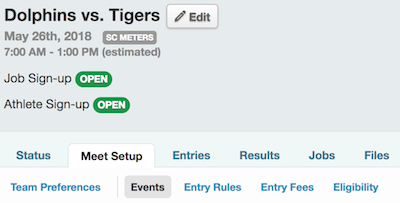First Things First – What is a Meet Template?
This season, SwimTopia has a new-look swim meet interface, and we’re introducing a new “Meet Template” feature. Defining a Meet Template allows you to create a list of events and rules for different types of meets throughout the season (e.g. standard dual meets, tri meets, Divisionals, Champs, or Invitationals). Once you have defined the templates, you can simply drop them into the appropriate swim meets on your calendar.
Using Meet Templates has many benefits:
- You can open meets for attendance declarations and job signups before you have the final meet schedule or event files from your league. When you later apply the Meet Template, no signup information is lost.
- For leagues that use SwimTopia league-wide, the league can define Meet Templates, which will pre-populate their teams’ templates with entry rules, participation requirements and more. This helps reduce errors or inconsistencies from team to team.
- Meet Templates save entry rules for different types of meets, and are easy to apply as you set up your season schedule.
- Meet Templates can be locked. Sometimes templates will be locked by the league, to keep meets standard from team to team, but teams can also lock their templates to improve standardization.
In our new-look swim meet interface, the items that are defined by the Meet Template can be found under “Meet Setup” (and to the right of the horizontal line): Events, Entry Rules, Meet Entry Fees, and Participation Requirements.
You can learn more in our Help Center article about creating and using Meet Templates.
Meet Entry Preferences and Entry Rules – What’s the Difference?
We just talked about the Meet Template, and the items governed under Meet Setup, but now you’re surely wondering what the other tab, “Team Preferences,” refers to and how that works in our new interface.
In our new system, we’ve divided out things that are considered “rules” and those that are considered “team preferences.” Rules are things that the league typically governs in by-laws and meet guides. Team preferences are just that, settings that relate more to how your team likes to collect entries and attendance information, and swim relays.
Just as the new Meet Templates allow you to “apply” the event list and rules for a given meet, you can now do that with your team preferences as well. The team can define their Meet Entry Preferences under Manage Team > Settings > Meet Entry Preferences. And then teams can “Apply” those preferences to each meet, making any necessary modifications on a meet-by-meet basis.
Where to Find What You’re Looking For
All the features you’ve known and loved in SwimTopia are still there! Things have just moved around and been categorized in new ways, to improve the clarity and work flow of running meet entries in SwimTopia. We’ve built in some light blue “notes” fields, and of course added hoverable question marks next to things, to explain new layouts, sections, and checkboxes. We’ve worked on and tested our new settings, systems, and headings, to make them as self-evident as possible. We think that clicking around on the new headings and reading the notes and descriptions should get you familiarized with everything pretty quickly! Here are some of the main changes:
- Status: now includes some fields that used to be in the “Edit” section of the meet, some that came under Jobs > Settings in each meet, and our new, handy, Auto Open/Close settings.
- Team Preferences and Entry Rules: now include items that used to be found under Entries > Individual Entries > Settings, and Entries > Relay Entries > Settings
We know these are big changes, and they’ll take some getting used to, but we always welcome feedback. Please email hello@swimtopia.com with any suggestions and feedback on our new layouts and features.
Please see our Help Center for more information and links to other related articles.



